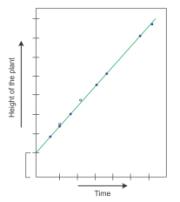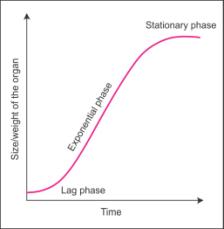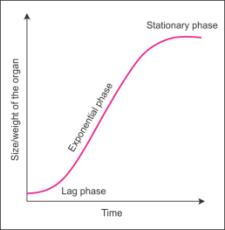Class 11-science NCERT Solutions Biology Chapter 13 - Plant Growth And Development
Plant Growth And Development Exercise 179
Solution 1
- Growth: Growth can be defined as an irreversible permanent increase in the size of an organ or its parts or even of an individual cell. It is generally accompanied by metabolic processes (both anabolic and catabolic) which occur at the expense of energy.
- Differentiation: Differentiation is the process whereby cells assume specialised morphologies and functions. It is also regarded as the process of maturation.
- Development: Development is a term which includes all changes that an organism goes through during its life cycle. For example, in plants, the process of changes from the germination of the seed to senescence is termed development.
- Dedifferentiation: The living differentiated cells which have lost the capacity to divide can regain the capacity of division under certain conditions. This phenomenon is termed dedifferentiation. For example, formation of meristems - interfascicular cambium and cork cambium - from fully differentiated parenchyma cells.
- Redifferentiation: While undergoing dedifferentiation, plant cells once again lose their capacity to divide and become mature. This process is called redifferentiation.
- Determinate growth: The ability of a cell, tissue or organism to grow for a limited period of time is called determinate growth. For example, growth in most of the plant parts is unlimited. Certain parts grow up to a certain level and then stop growing. This kind of growth is called determinate growth.
- Meristem: The meristem is a group of cells which are in continuous state of division and add new cells to the body.
- Growth rate: The increased growth per unit time is termed growth rate.
Solution 2
Like most organisms, plants also go through various phases of growth. When a seed is germinating, the parameters of growth will be different compared to growth of a mature plant. In plants, growth is said to have taken place when the amount of protoplasm increases. For example, a cell formed immediately after mitosis increases in the amount of protoplasm and then matures into a specific kind of cell.
Solution 3
(a) Arithmetic growth: It refers to a pattern of growth which increases at a constant amount per unit time. The simplest expression of arithmetic growth is exemplified by a root elongating at a constant rate.
Mathematically, it is expressed as
Lt = Lo + rt
Lt = length at time 't'
Lo = length at time 'zero'
r = growth rate/elongation per unit time

(b) Geometric growth: In this type, the size or number increases in a multiplicative fashion, i.e. 2, 4, 8, 16, 32, .... In most systems, the initial growth is slow (lag phase), and it increases rapidly thereafter - at an exponential rate (log or exponential phase). Here, both the progeny cells following mitotic cell division retain the ability to divide and continue to do so. However, with limited nutrient supply, the growth slows down leading to a stationary phase.

The exponential growth can be expressed as
W1 = W 0 ert
W1 = final size (weight, height, number etc.)
W 0 = initial size at the beginning of the period
r = growth rate
t = time of growth
e = base of natural logarithms
Here, r is the relative growth rate and is also the measure of the ability of the plant to produce new plant material, referred to as efficiency index. Hence, the final size of WI depends on the initial size WO.
(c) Sigmoid growth curve: It is an S-shaped graph produced on plotting growth against time. It has four main components – a slow lag phase, a rapid log or exponential phase, phase of diminishing growth and steady or stationary phase.

(d) Absolute growth rate: It is the total growth per unit time.
Relative growth rate: It is the growth per unit time per unit initial growth.
Solution 4
The following are five plant growth regulators:
- Auxins
- Gibberellins
- Cytokinins
- Ethylene
- Abscisic acid
Discovery of auxins:
The existence of auxin, the first plant growth hormone to be discovered, came from the work of Darwin. He and his son while working on canary grass demonstrated the bending of grass coleoptiles towards a unilateral source of light. Covering the tip with a black cap resulted in the loss of sensitivity of the plant towards light. Replacement of the tip again caused bending towards the source of light.
Similar observations were made by Boysen-Jensen on oat coleoptiles. He decapitated the seedling, smeared a bit of gelatine on the cut end, replaced the tip on the gelatine and found that the coleoptile bends towards the source of light.
Final proof was provided by Went in 1928 that some material substance is involved in unilateral growth and that this substance is provided by the apex.
Physiological functions:
- Auxins stimulate respiration by increasing the availability of respiratory substrate.
- They control plant cell growth.
- They cause the phenomenon of apical dominance.
- They control division in the vascular cambium and xylem differentiation.
- They induce parthenocarpy and prevent abscission of leaves and fruits.
Horticultural applications:
- They are used as the rooting hormones in stem cuttings.
- 2-4 D is used as weedicide to kill broadleaf, dicotyledonous weeds.
- They induce parthenocarpy in tomatoes.
- They promote flowering in pineapple and litchi.
Solution 5
Abscisic acid increases the tolerance of plants to various kinds of stress. Therefore, it is also called stress hormone. Its production is stimulated by drought, water logging and other adverse conditions. For example, abscisic acid closes stomata and prevents the loss of water during transpiration in drought conditions.
Solution 6
Plants are built in a modular fashion where the structure is never complete because their tips are open ended, where growth and subsequently differentiation are continuously taking place due to the presence of meristems, shoot apical meristem and root apical meristem. Cells of these meristems divide throughout plant life and later differentiate into different types of tissues and organs.
Solution 7
Long day plants are those plants which come to flower only when they receive photoperiods above a critical day length; for example, 9 hours in Oat. Short day plants come to flower only when they get light below a critical day length; for example, 15.6 hours of dark period in Xanthium. At 9.5 hours, both Oat and Xanthium will flower simultaneously. This shows that both a short day plant and a long day plant can produce flowers simultaneously in a given place.
Solution 8
(a) Auxins
(b) Ethylene
(c) Cytokinins
(d) Auxins
(e) Gibberellins
(f) Abscisic acid
Solution 9
The hormone responsible for photoperiodism is found in leaves which are removed in a defoliated plant. So, it will be devoid of such hormones and will not respond to the photoperiodic cycle.
Plant Growth And Development Exercise 180
Solution 10
(a) GA3 increases the length of the axis. This property will help increase the length of the axis so that the yield of rice can be increased.
(b) When dividing cells stop differentiating, it is the maturity stage of that part of the plant. Further growth of that particular region will stop.
(c) A rotten fruit emits ethylene which will hasten the ripening of unripe fruits.
(d) There will be less cell division, and the culture will not grow according to the target.

